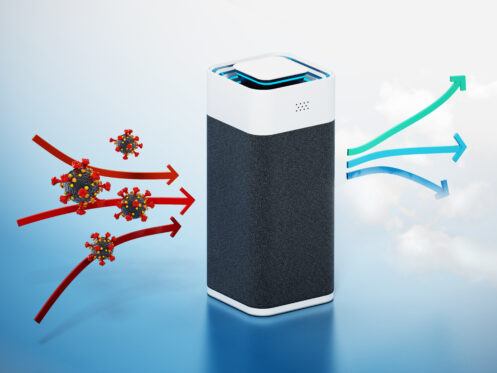Both the EPA and CDC warn that indoor air pollution is among the top health risks in the U.S. An air purifier is the most effective way of removing those impurities from the air. While air purifiers do vary between brands and models, they generally function in the same manner.
Airflow
Most air purifiers work by forcing air through a series of filtration stages. They draw in air from the home, filter it and return it. The effectiveness and volume of this filtration will determine your indoor air quality. The more air a system can move, the more impurities it can filter out.
Portable vs. Integrated
How an air purifier draws in and returns this air is a matter of its design. Portable air purifiers generally have an internal fan that creates the suction. Note that portable doesn’t necessarily mean small. There are units small enough to take with you from room to room. There are also room air purifiers that provide upward of 1,500 square feet of coverage.
Integrated or whole-house air purifiers are part of a home’s central HVAC system. These systems generally take advantage of the airflow created by the heating and cooling system. Typically, our HVAC technicians will position it near the supply vent. This allows it to filter air as it enters the system and before it reaches your other HVAC equipment. The system then returns the filtered air to the home via the return vents.
Air Changes
It’s necessary to size an air purifier based on a particular room or your entire home. You need to know the volume of the space. That includes square footage but also ceiling height. You also need to know how many air changes a system will provide at that volume. Providing four air changes an hour is generally considered the minimum you should target. The CDC recommends five air changes or more. You may want even higher performance if you have a family member with respiratory health concerns.
Media Filters
Filtration occurs when your HVAC system moves the air through a series of media filters. These filters extract impurities from the air. The typical air purifier will have three media filter stages: prefiltration, activated charcoal and high-efficiency particulate air (HEPA) filtration.
Prefilter
Manufacturers design their prefilters to block the largest particulate matter (PM). This includes PM with a diameter greater than 2.5 microns (PM2.5). Smaller particles are fine particulate matter. Fine PM is what modern medicine associates with cardiovascular and lung diseases. The goal of the prefilter is the keep the air purifier clean and extend the life of the other media filters.
Activated Charcoal
Activated charcoal provides some PM filtration as well, but it’s there for its absorptive qualities. It absorbs bad odors. It also absorbs a wide range of chemicals and gases, including volatile organic compounds. Once absorbed, these compounds become inert and are no longer dangerous.
HEPA Filtration
HEPA filtration is where most of the heavy lifting occurs in an air purifier. These filters have a dense array of fibers that are able to trap very small particles. The denseness allows for substantial surface area and a long filter life. Standard HEPA filters can filter solid and liquid PM0.3. That is good enough for most households, but you do have the option of medical-grade HEPA. It filters PM0.1.
Electrostatic and Electronic Filtration
Electrostatic and electronic filtration are an alternative to mechanical filtration. They work through electrical charges and attraction. Some brands use this in combination with HEPA filters. In residential applications, they’re generally not effective enough to be worth the cost. HEPA filters are much less expensive.
UV Filtration
Some air purifiers pass the air around a germicidal UV light after the mechanical filtration. This removes bacteria and viruses. Many experts believe it’s better to install UV lamps in your ducts. This is because UV filtration is more effective with slower-moving air due to the longer exposure. An air purifier, on the other hand, benefits from more airflow.
Your Local IAQ Experts in El Paso
If you’d like to install an air purifier in El Paso or the surrounding areas, E.P. Omega Air Conditioning LLC can help. Our IAQ experts also clean ductwork and install dehumidifiers and humidifiers. In addition, we have HVAC technicians who install, maintain and repair all types of HVAC systems. That includes gas and electric furnaces, air conditioners, heat pumps, boilers, ductless mini-split systems and zoned HVAC units. Our duct specialists can also install and repair ductwork. Call us today or contact us online with any questions about these services or to schedule an appointment.
